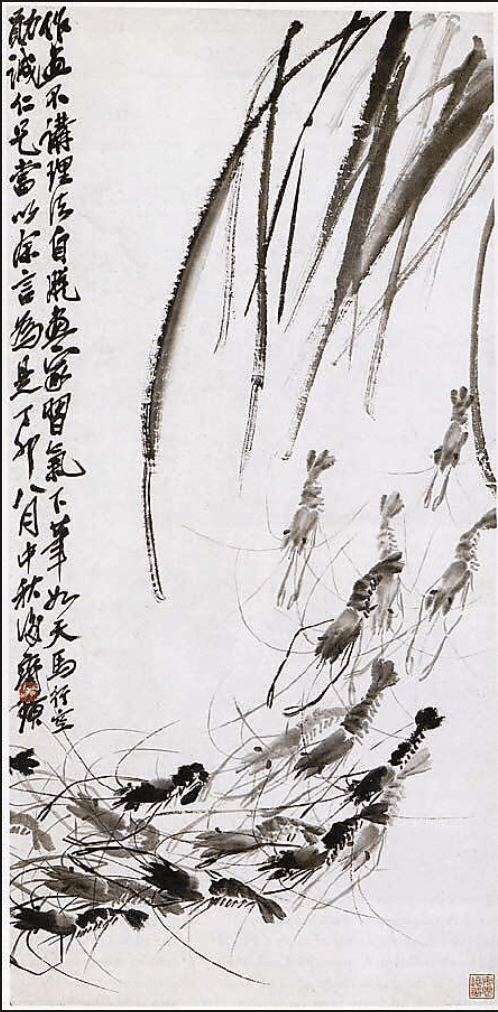Shrimp by Qi Baishi is a painting of many shrimp with some blades of grass above them. This black and white painting is dated for sometime in 1927. This piece of art is a hanging scroll and is ink on paper, with dimensions of 38 3/8 inches by 18 3/4 inches. Each shrimp seems to be created in the same style, but some are darker than the others, maybe showing Qi Baishi trying different techniques. It seems to be underwater, where a shrimp would live, but it is not colored. The black and white allow focus to the shrimp and Qi Baishi’s playfulness. It is meant to be a simple painting, but also realistic, with the shrimp seeming to be something out of a photo. It is inscribed on the side, and it reads: “If you can forget painting theory, you will not suffer from its deeply-rooted bad effects. Then your brush will fly like the heavenly horse moving through the sky. Brother Xuncheng will agree with me.” Qi Baishi was known for being creative, and this reflects that saying paint as you want to paint. In this painting, you can see how he does not follow any rules but paints with the way he wants, like a child, something he loved to do. He loved to paint with a spontaneity, something not familiar at the time. This painting is currently not on view but was in New York in 1988 and 2001, and New Haven in 1987. The timeline of this painting, being created in 1927, is very important. At the time Communists were being attacked and on the run from the Nationalists, and the shrimp seem to be leaving the grass in large numbers, showing that connection. His inscription also goes with that by saying forget the old ways, and start your own, which was very in line with the communist party. This goes with Qi Baishi being named the people’s artist by Mao Zedong in 1953.
Bibliography:
“Shrimp.” The Met’s Heilbrunn Timeline of Art History, www.metmuseum.org/art/collection/search/49648.
LARKING, MATTHEW. “Qi Baishi Updated Literati Painting with New Subjects.” The Japan Times, 21 Sept. 2006, www.japantimes.co.jp/culture/2006/09/21/arts/qi-baishi-updated-literati-painting-with-new-subjects/#.XFHO4i2ZPGI.



February 4, 2019 at 6:17 pm
This is a very interesting analysis! I really like how you talk about the relationship between the simplicity of the painting overall and the realism of the shrimp. This creates a very powerful juxtaposition that I had not thought about. My artist, Chen Yifei, painted in the realist style but now I wonder if I might be able to find some abstract or simple elements within the realist paintings that convey a deeper message through juxtaposition. Also, great job providing historical context – I can definitely see how the painting relates to the political climate of the time!
February 4, 2019 at 8:53 pm
I like how you relate the shrimp and what appears to be their collective effort to either evacuate or relocate to the political pressure Communists felt in the late 1920s that also caused them to continually evade the advancements of the Nationalists. I think another powerful idea behind the shrimp imagery is that they are a species that represents strength in numbers. The same thing can certainly be said for the Communist movement in China seeing how it sought to empower the vast majority of the Chinese who were neglected/exploited by the upper class. I think this reality aligns with the message Fu Baoshi conveyed in his Ode to Yuhuatai because it speaks to Communist resolve and their willingness to endure. I believe that what appears to be mere depictions of animals or landscape is certainly meant to represent much more than meets the eye.